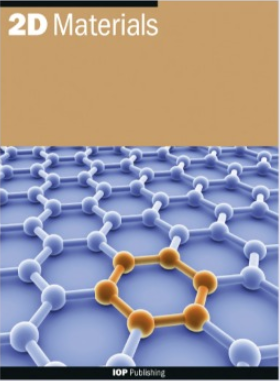使用飞秒脉冲的单层六方氮化硼的介电击穿和亚波长图形。
IF 4.3
3区 材料科学
Q2 MATERIALS SCIENCE, MULTIDISCIPLINARY
引用次数: 0
摘要
六方氮化硼(hBN)已成为一种有前途的二维(2D)材料,在电子和光子学领域有许多应用。虽然hBN的线性和非线性光学特性已经被广泛研究,但hBN与高强度激光脉冲的相互作用对于实现高谐波产生、作为量子发射体产生确定性缺陷以及该材料的无电阻图形化很重要,但尚未被研究。本文首次系统地研究了单飞秒激光脉冲诱导化学气相沉积(CVD)生长的hBN单层的介电击穿。我们报告的击穿通量为0.7 jcm−2,比其他单层二维材料的击穿通量至少高7倍。演示了清洁去除hBN而不留下痕迹或造成侧向损伤。烧蚀特征具有优异的保真度和非常小的边缘粗糙度,我们将其归因于其具有三重对称的非均质特性所带来的超高断裂韧性。此外,尽管已知cvd生长的hBN中存在大量缺陷,但我们通过实验和理论证明,其非线性光学击穿几乎是固有的,因为缺陷仅略微降低击穿阈值。除此之外,我们观察到hBN单层的击穿阈值比它们的等效体低4 - 5倍。如果单层中的载流子产生由于其二维性质而本质上增强,则最后两个观察结果可以理解。最后,我们展示了具有亚波长特征尺寸的hBN中孔和线阵列的激光图像化。我们的工作推进了强场下光-hBN相互作用的基础知识,并牢固地建立了飞秒激光器作为高保真hBN单层无电阻图像化的新型和有前途的工具。本文章由计算机程序翻译,如有差异,请以英文原文为准。
Dielectric breakdown and sub-wavelength patterning of monolayer hexagonal boron nitride using femtosecond pulses.
Abstract Hexagonal boron nitride (hBN) has emerged as a promising two-dimensional (2D) material for many applications in electronics and photonics. Although its linear and nonlinear optical properties have been extensively studied, the interaction of hBN with high-intensity laser pulses, which is important for realizing high-harmonic generation, creating deterministic defects as quantum emitters, and resist-free patterning in this material, has not been investigated. Here we report the first systematic study of dielectric breakdown in chemical vapor deposition (CVD)-grown hBN monolayers induced by single femtosecond laser pulses. We report a breakdown fluence of 0.7 J cm −2 , which is at least 7× higher than that of other monolayer 2D materials. A clean removal of hBN without leaving traces behind or causing lateral damage is demonstrated. The ablation features exhibit excellent fidelity with very small edge roughness, which we attribute to its ultrahigh fracture toughness due to its heterogeneous nature with three-fold symmetry. Moreover, even though defects are known to be abundant in CVD-grown hBN, we show experimentally and theoretically that its nonlinear optical breakdown is nearly intrinsic as defects only marginally lower the breakdown threshold. On top of this, we observe that hBN monolayers have a 4–5× lower breakdown threshold than their bulk equivalent. The last two observations can be understood if the carrier generation in monolayers is intrinsically enhanced due to its 2D nature. Finally, we demonstrate laser patterning of array of holes and lines in hBN with sub-wavelength feature sizes. Our work advances the fundamental knowledge of light-hBN interaction in the strong field regime and firmly establishes femtosecond lasers as novel and promising tools for resist-free patterning of hBN monolayers with high fidelity.
求助全文
通过发布文献求助,成功后即可免费获取论文全文。
去求助
来源期刊

2D Materials
MATERIALS SCIENCE, MULTIDISCIPLINARY-
CiteScore
10.70
自引率
5.50%
发文量
138
审稿时长
1.5 months
期刊介绍:
2D Materials is a multidisciplinary, electronic-only journal devoted to publishing fundamental and applied research of the highest quality and impact covering all aspects of graphene and related two-dimensional materials.
 求助内容:
求助内容: 应助结果提醒方式:
应助结果提醒方式:


